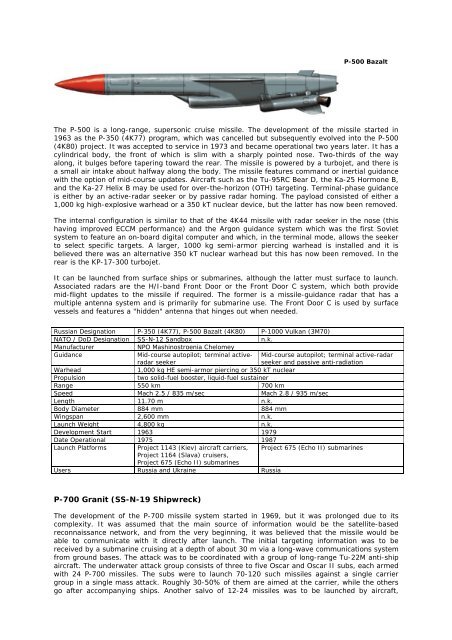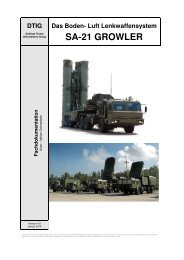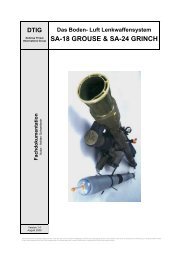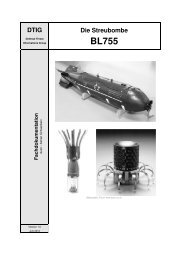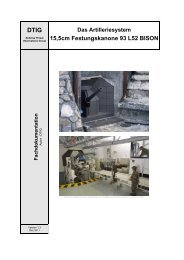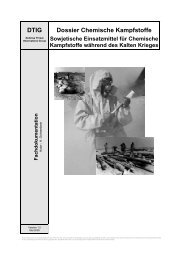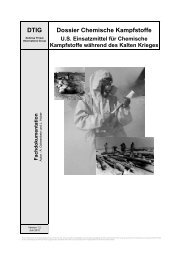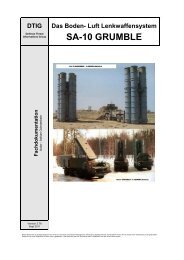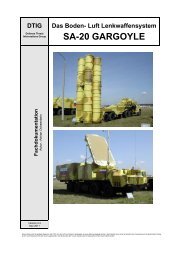RUSSIAN/SOVIET SEA-BASED ANTI-SHIP MISSILES Specia ... - DTIG
RUSSIAN/SOVIET SEA-BASED ANTI-SHIP MISSILES Specia ... - DTIG
RUSSIAN/SOVIET SEA-BASED ANTI-SHIP MISSILES Specia ... - DTIG
You also want an ePaper? Increase the reach of your titles
YUMPU automatically turns print PDFs into web optimized ePapers that Google loves.
P-500 Bazalt<br />
The P-500 is a long-range, supersonic cruise missile. The development of the missile started in<br />
1963 as the P-350 (4K77) program, which was cancelled but subsequently evolved into the P-500<br />
(4K80) project. It was accepted to service in 1973 and became operational two years later. It has a<br />
cylindrical body, the front of which is slim with a sharply pointed nose. Two-thirds of the way<br />
along, it bulges before tapering toward the rear. The missile is powered by a turbojet, and there is<br />
a small air intake about halfway along the body. The missile features command or inertial guidance<br />
with the option of mid-course updates. Aircraft such as the Tu-95RC Bear D, the Ka-25 Hormone B,<br />
and the Ka-27 Helix B may be used for over-the-horizon (OTH) targeting. Terminal-phase guidance<br />
is either by an active-radar seeker or by passive radar homing. The payload consisted of either a<br />
1,000 kg high-explosive warhead or a 350 kT nuclear device, but the latter has now been removed.<br />
The internal configuration is similar to that of the 4K44 missile with radar seeker in the nose (this<br />
having improved ECCM performance) and the Argon guidance system which was the first Soviet<br />
system to feature an on-board digital computer and which, in the terminal mode, allows the seeker<br />
to select specific targets. A larger, 1000 kg semi-armor piercing warhead is installed and it is<br />
believed there was an alternative 350 kT nuclear warhead but this has now been removed. In the<br />
rear is the KP-17-300 turbojet.<br />
It can be launched from surface ships or submarines, although the latter must surface to launch.<br />
Associated radars are the H/I-band Front Door or the Front Door C system, which both provide<br />
mid-flight updates to the missile if required. The former is a missile-guidance radar that has a<br />
multiple antenna system and is primarily for submarine use. The Front Door C is used by surface<br />
vessels and features a "hidden" antenna that hinges out when needed.<br />
Russian Designation P-350 (4K77), P-500 Bazalt (4K80) P-1000 Vulkan (3M70)<br />
NATO / DoD Designation SS-N-12 Sandbox n.k.<br />
Manufacturer NPO Mashinostroenia Chelomey<br />
Guidance Mid-course autopilot; terminal activeradar<br />
seeker<br />
Mid-course autopilot; terminal active-radar<br />
seeker and passive anti-radiation<br />
Warhead 1,000 kg HE semi-armor piercing or 350 kT nuclear<br />
Propulsion two solid-fuel booster, liquid-fuel sustainer<br />
Range 550 km 700 km<br />
Speed Mach 2.5 / 835 m/sec Mach 2.8 / 935 m/sec<br />
Length 11.70 m n.k.<br />
Body Diameter 884 mm 884 mm<br />
Wingspan 2,600 mm n.k.<br />
Launch Weight 4,800 kg n.k.<br />
Development Start 1963 1979<br />
Date Operational 1975 1987<br />
Launch Platforms Project 1143 (Kiev) aircraft carriers,<br />
Project 1164 (Slava) cruisers,<br />
Project 675 (Echo II) submarines<br />
Project 675 (Echo II) submarines<br />
Users Russia and Ukraine Russia<br />
P-700 Granit (SS-N-19 Shipwreck)<br />
The development of the P-700 missile system started in 1969, but it was prolonged due to its<br />
complexity. It was assumed that the main source of information would be the satellite-based<br />
reconnaissance network, and from the very beginning, it was believed that the missile would be<br />
able to communicate with it directly after launch. The initial targeting information was to be<br />
received by a submarine cruising at a depth of about 30 m via a long-wave communications system<br />
from ground bases. The attack was to be coordinated with a group of long-range Tu-22M anti-ship<br />
aircraft. The underwater attack group consists of three to five Oscar and Oscar II subs, each armed<br />
with 24 P-700 missiles. The subs were to launch 70-120 such missiles against a single carrier<br />
group in a single mass attack. Roughly 30-50% of them are aimed at the carrier, while the others<br />
go after accompanying ships. Another salvo of 12-24 missiles was to be launched by aircraft,


